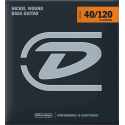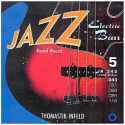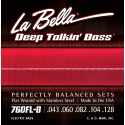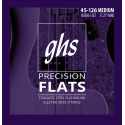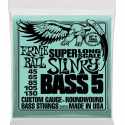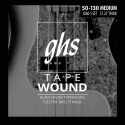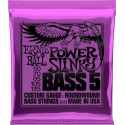5 Strings
New products
-

STAGG MXS-A1 PLUS Adjustable mixer or keyboard stand with sloped legs
- Top dimensions (W x H x D): 73 to 111.5 x 59 to 71 x 32 cm (28.7 to...
115,00 € -

STAGG STC-24C/T Polyethylene case for cymbals
- Suitable for cymbal sizes up to 24"- Foam padded interior- Built-in...
330,00 € -

-

STAGG PBH 390 BKP VBK Highgloss black hydraulic piano bench with fireproof black velvet top
- Structure material: Rubber wood- Top material: Black velvet- Finish:...
250,00 € -

MEINL SINGLE SHAKER ALU GRAND
Single shaker, large model Meinl Samba shakers are ideal for street...
18,00 € -

CORT GUITAR AD810E SATIN BLACK
AD810E, spruce top, mahogany back & sides, mahogany neck, rosewood...
246,00 €
5 Strings
Subcategories
30-125
A set of strings for a 5-string electric bass with a range of 30-125 is a series of five strings of different thicknesses that are designed to be mounted on a five-string electric bass. The strings are designed to produce a specific frequency range for each string to create a particular sound.
The drawbar indicates the thickness of the thinnest string (in millimeters) and the thickest string in the set. For a set of 30-125 strings, the thinnest string has a diameter of 0.030 inch (0.76 mm) and the thickest string has a diameter of 0.125 inch (3.18 mm).
The thinner strings are generally used for the highest notes, while the thicker strings are used for the lowest notes. The middle strings are used for the middle notes. The combination of all these strings gives a wider range of notes to play different styles of music.
It is important to choose the right set of strings for your playing style and type of electric bass. Thinner strings are often easier to play and are suitable for faster styles of music, while thicker strings are suitable for slower, heavier styles of music.
In summary, a set of strings for a 5-string electric bass drawing from 30-125 is a series of five strings designed to be mounted on a five-string electric bass, with thicknesses ranging from .030 inch (0.76 mm) to .125 inch (3.18 mm). Each string produces a specific frequency range to create a particular sound. The choice of strings depends on the style of playing and the type of electric bass being used.
40-120
A set of strings for a 5-string electric bass with a drawbar of 40-120 is a set of five steel strings specially designed to be used on a five-string electric bass.
The tension of the strings indicates the force needed to pluck and vibrate them. In this case, the smallest string on the bass, which is closest to the ground, has a draw of 40, while the largest string has a draw of 120.
Thicker strings tend to produce lower tones, while thinner strings produce higher tones. In general, bassists choose strings with a draw and diameter that match their playing style, technique and the genre of music they play.
By using a set of strings designed specifically for a five-string electric bass, you ensure that the strings are the right length and tension to produce the clearest, most accurate sound possible. This can help improve the playability of the instrument and optimize the overall sound quality of the bass.
40-125
A set of strings for a 5-string electric bass with a drawbar of 40-125 refers to a set of five metal strings that are designed specifically for use on a five-string electric bass.
The 40-125 draw measurement corresponds to the diameters of the thinnest and thickest strings in the set. The first number (40) represents the diameter of the thinnest string (the G string) and the second number (125) represents the diameter of the thickest string (the low B string). The other strings will have intermediate diameters.
A set of strings with a lighter gauge will be easier to play, but will produce a less powerful and shallower sound. On the other hand, a set of strings with a higher tension will be more difficult to play, but will produce a louder and richer sound.
It is important to choose a set of strings that is appropriate for your playing style, skill level and musical genre. Jazz bassists often prefer lighter gauge strings, while heavy metal bassists often opt for thicker strings.
It is also important to replace your strings regularly, as worn strings can affect the sound quality and playability of your electric bass.
40-126
A set of strings for a 5-string electric bass drawing 40-126 is a set of five strings designed for use on a five-string electric bass. The numbers 40-126 refer to individual string thicknesses measured in thousandths of an inch (sometimes called gauges), which correspond to the tension of the string and the pitch of the note produced when played.
The lowest number, 40, refers to the thinnest string (the string closest to the ground) and 126 refers to the thickest string (the string closest to the bass head). The string gauge can influence the sound and feel of the instrument, as well as its ability to hold the tuning.
A set of strings for a 5-string electric bass drawing 40-126 can be used in a variety of musical styles, from jazz to rock to metal. Thicker strings can produce a heavier, more powerful sound, while thinner strings can allow for greater playability and musical expression. It is important to note that using the right set of bass strings for your playing style and personal preferences can greatly enhance your playing experience and the sound of your instrument.
40-128
A set of strings for a 5-string electric bass drawing 40-128 is a set of five metal strings specifically designed for use on a five-string electric bass. The strings are graded according to their diameter and draw tension.
The numbers "40-128" indicate the diameter of the thinnest and thickest strings in the set, measured in thousandths of an inch. Thus, the thinnest (highest pitch) string in the ensemble has a diameter of .040 inches, while the thickest (lowest pitch) string has a diameter of .128 inches.
The draw tension of each string determines the force needed to hold it at a certain pitch, as well as the playing feel and sound produced. Strings with a higher draw tension generally have a brighter, more defined sound, while strings with a lower draw tension have a softer, rounder sound.
Using a set of strings of this size, a bassist can play lower notes than on a standard four-string bass. The thicker strings allow for lower notes to be played with increased clarity and definition, while the extra string provides a wider range of notes.
It's important to note that string tension can affect how your bass is set up and plays. If you decide to switch to a heavier or lighter set of strings, you may need to adjust the height of your strings and the curvature of your neck to avoid unwanted bends and squeaks.
43-118
A set of strings for a 5-string electric bass drawing from 43-118 is a set of five strings of different diameters that are designed to be used with a five-string electric bass.
The first number, 43, represents the diameter of the thinnest string in the set, the G string, while the second number, 118, represents the diameter of the thickest string, the B string.
The string tension is the amount of tension exerted on the strings of the bass, and is usually determined by a combination of the string diameter and the length of the bass. The higher the tension on the strings, the more difficult they will be to play but the brighter and more resonant the sound.
Choosing a set of strings for a 5-string electric bass that draws from 43-118 gives you a full range of notes for playing modern music, from jazz to metal to pop. The thinner strings provide a clearer, more precise sound for fast, complex bass parts, while the thicker strings provide a deeper, more bassy tone for heavier, more powerful bass parts.
43-128
A set of strings for a 43-128 draw 5-string electric bass is a set of five metal strings designed to be installed on a five-string electric bass.
The 43-128 gauge refers to the thickness of each string measured in thousandths of an inch (or hundredths of a millimeter). The draw can vary depending on the player's preference and the style of music played. Thicker strings produce a deeper, more powerful sound, while thinner strings are lighter and easier to play for faster playing techniques.
Bass strings are usually made of stainless steel, nickel or a combination of both. Stainless steel strings have a brighter, more durable sound, while nickel strings have a warmer, softer sound.
It is important to note that bass strings should be replaced regularly to avoid loss of sound and resonance. The replacement of strings depends on the frequency of playing and the intensity of the player's performance.
44-121
A set of strings for a 5-string electric bass drawing 44-121 is a set of five metal strings designed for use on a five-string electric bass. The strings are graded according to their thickness, or gauge, measured in millimeters. The 44-121 string set indicates that the thinnest bass string (the highest pitch string) is 0.44 millimeters thick, while the thickest bass string (the lowest pitch string) is 1.21 millimeters thick.
Thicker bass strings produce deeper, more powerful sounds, while thinner strings have a higher, softer sound. Five-string electric basses are often used in music styles that require lower notes and a wider range of notes, such as jazz, rock and metal.
It is important to note that the tension of the strings can vary depending on their thickness, which can affect the comfort of playing and the ease of handling the electric bass. It is therefore important to choose a set of strings that suits your playing style and personal preferences.
44-126
A set of strings for a 5-string electric bass drawing from 44-126 is a set of five metal strings designed for use on a five-string electric bass. The strings are designed to produce an accurate and consistent sound when played, and are typically made from different materials to provide a variety of tones and playing feel.
The numbers 44-126 refer to the gauge of the strings, which is their thickness in thousandths of an inch. The thinnest string has a diameter of .044 inches and the thickest string has a diameter of .126 inches. Thicker strings tend to produce a fuller, more powerful sound, while thinner strings are easier to play and have a softer feel under the fingers.
When purchasing a set of strings for your 5-string electric bass, it's important to make sure that they are suitable for your playing style and instrument. Electric bass strings come in a variety of materials, including stainless steel, nickel and cobalt, which can affect the sound and life of the strings. In addition, the gauge of the strings can vary depending on your preferences and how you want your bass to sound. So it's important to do your research to find the right strings for your bass and playing style.
44-128
A set of strings for a 5-string electric bass drawing 44-128 is a set of five strings specifically designed for a five-string electric bass. The numbers "44-128" indicate the thickness of the strings, measured in thousandths of an inch, for the thinnest (E string) and thickest (B string).
The 5-string electric bass string set is usually made up of five steel string strings, with an extra string over a standard four-string bass. The extra string is usually a low E (B), which is thicker and lower than the other strings.
Choosing a set of electric bass strings will depend on the style of music you play, the sound you're looking for, and your personal preferences for feel and playability. Thicker strings tend to produce a fuller, richer sound, while thinner strings have a brighter, clearer sound. String gauge can also affect string tension and playing comfort.
44-130
A set of strings for a 5-string electric bass drawing 44-130 is a set of five metal strings specially designed for use with a five-string electric bass.
The numbers 44-130 correspond to the thickness of each string in thousandths of an inch. The thinnest string is usually the first string, which is tuned to the highest note on the instrument, while the thickest string is the fifth string, tuned to the lowest note.
Thicker strings produce deeper, more powerful sounds, while thinner strings produce higher, clearer sounds. The tension of each string is also important, as it affects the playability and response of the instrument.
Electric bass string sets are available in a wide variety of thicknesses, materials and brands. It is important to choose the right set of strings for your playing style and type of bass to get the best sound and playability.
45-105
A set of strings for a 5-string electric bass drawing 45-105 is a set of five strings of different thicknesses designed for use on a five-string electric bass.
The first string, the thinnest, has a diameter of .045 inch (about 1.14 mm) and is intended to be used for the highest string, while the fifth string, the thickest, has a diameter of .105 inch (about 2.67 mm) and is intended to be used for the lowest string. The intermediate strings have proportional diameters, usually with a difference of about 0.025 inch (about 0.64 mm) between each string.
Strings are also made of different materials such as steel, nickel and stainless steel, each with its own sound and playing properties. String tension is the amount of force required to stretch the strings to the proper tension for a five-string bass.
The 45-105 drawbar set of 5-string electric bass strings would suit a variety of playing styles, offering a balanced response and versatile tone.
45-125
A set of strings for a 5-string electric bass with a draw range of 45-125 is a set of five steel strings specially designed for a five-string electric bass.
The numbers "45-125" refer to the thickness of the individual strings in the set. Bass strings are often graded by their thickness in inches, with the thickest to the thinnest. For example, a "0.125" bass string is thicker than a "0.045" bass string. In this case, the numbers 45-125 mean that the thinnest of the five strings in the set is 0.045 inches thick, while the thickest is 0.125 inches thick.
Electric bass string sets are available in a wide variety of different gauges to meet the individual preferences of bassists. A lighter set of strings (e.g., 40-100) might be preferred by some bassists for a softer, easier feel, while a heavier set of strings (e.g., 50-135) might be preferred by other bassists for a louder, more powerful sound.
It is important to note that bass strings degrade over time and should be replaced regularly to ensure optimal sound quality and comfortable playability.
45-126
A set of strings for a 5-string electric bass with a 45-126 gauge is a set of five steel strings designed for use on a five-string electric bass. The 45-126 gauge refers to the thickness of each string, measured in thousandths of an inch, from thinnest (the E string) to thickest (the B string).
These strings are designed to provide the proper tension and strength for a five-string electric bass, allowing for comfortable playability and good tonal response. The thicker strings produce lower notes, while the thinner strings produce higher notes.
It is important to note that electric bass strings can vary in material and construction, which affects their sound and durability. Stainless steel strings tend to have a brighter sound and longer life than nickel strings, which have a warmer, rounder sound.
It is also important to change the strings on your electric bass regularly to maintain good sound quality and avoid string breakage. In general, it is recommended to change the strings every three to six months, depending on how often the instrument is used.
45-128
A set of strings for a 5-string electric bass drawing 45-128 is a set of five metal strings designed specifically for use on a five-string electric bass. The numbers 45-128 refer to the thickness of the strings, measured in thousandths of an inch (or sometimes hundredths of a millimeter).
String tension is the amount of tension exerted on the strings when they are tuned to the appropriate pitch. A higher tension means that the strings are tighter and require more force to play, while a lower tension means that the strings are less tense and require less force to play.
In the case of a set of 5-string electric bass strings with a draw range of 45-128, this means that the thinnest string (the highest string in terms of pitch) is 0.045 inches in diameter and the thickest string (the lowest string in terms of pitch) is 0.128 inches in diameter. The intermediate strings have diameters proportional to their respective pitch.
Choosing a set of electric bass strings depends on a number of factors, including the style of music you play, the tone you're looking for, your playing technique, and your personal preference for playing feel. String sets with a higher drawbar are generally better suited for aggressive playing styles, such as heavy metal, while string sets with a lower drawbar may be preferable for softer playing styles, such as jazz.
45-130
A set of strings for a 5-string electric bass drawing 45-130 is a set of five strings specifically designed for use on a 5-string electric bass. The strings are usually made from a metal alloy, such as stainless steel or nickel, and have different diameters to produce different pitch notes.
The numbers "45-130" refer to the diameters of individual strings, expressed in thousandths of an inch. The thinnest diameter is that of the highest string, which measures 0.045 inch (or 1.14 mm), while the thickest diameter is that of the lowest string, which measures 0.130 inch (or 3.30 mm).
The lower strings produce lower, more powerful notes, while the higher strings produce higher, more subtle notes. 5-string electric basses are popular with bassists because they offer a wider range of notes than traditional 4-string basses, and the thicker strings allow you to play lower notes with more clarity and punch.
In short, a set of strings for a 5-string electric bass drawing from 45-130 is a set of five strings of different diameters designed to provide a wider range of notes and better sound quality for bassists playing 5-string electric basses.
45-135
A set of strings for a 5-string electric bass with a 45-135 gauge is a set of five strings designed specifically for a five-string electric bass. The numbers 45-135 indicate the thickness of each string in thousandths of an inch, from thinnest (the highest string) to thickest (the lowest string).
The choice of bass strings can have a significant impact on the sound of the instrument. Thicker strings tend to produce a richer, deeper sound, while thinner strings tend to produce a brighter, clearer sound.
Electric bass string sets are available in different configurations depending on the number of strings on the instrument and the musician's preference in string thickness. Experienced players can even choose strings of different materials, such as stainless steel or nickel, to achieve a specific sound.
In summary, a set of strings for a 5-string electric bass drawing 45-135 is a set of five strings specifically designed for a five-string electric bass, with a thickness ranging from 45 to 135 thousandths of an inch for each string.
49-129
A set of strings for a 5-string electric bass drawing 49-129 is a set of five metal strings designed to be installed on a five-string electric bass. The numbers 49-129 refer to the thickness of each string, measured in thousandths of an inch, from thinnest (the highest string) to thickest (the lowest string).
Electric bass string sets are available in a variety of thicknesses and materials, and the choice of string set depends on the style of music the bassist plays and his or her personal preferences for sound and feel.
Thicker strings are generally used for deeper, lower tones, while thinner strings are used for higher, clearer tones. Stainless steel strings tend to have a brighter, clearer response, while nickel strings have a softer, warmer sound.
It is important to note that strings should be replaced regularly, as they wear out with time and use, which can affect the sound quality and playability of the instrument. Bassists should be aware of their string tension and adjust the action of their instrument accordingly to avoid problems with playability and comfort.
50-130
Ein Saitensatz für einen 5-saitigen E-Bass mit einer Zugstärke von 50-130 ist ein Satz von fünf Saiten, die speziell für die Verwendung auf einem 5-saitigen E-Bass entwickelt wurden. Die Saiten werden nach ihrer Stärke beschriftet, die üblicherweise in Tausendstel Zoll oder Millimetern angegeben wird.
In diesem Fall haben die Saiten Zugstärken von 50 bis 130, was bedeutet, dass die dünnste Saite 0,050 Zoll (oder ca. 1,27 mm) dick ist, während die dickste Saite 0,130 Zoll (oder ca. 3,3 mm) dick ist.
Die dickeren Saiten neigen dazu, einen tieferen und tieferen Ton zu erzeugen, während die dünneren Saiten eher einen höheren Ton erzeugen. Spieler können ihren Klang je nach der Musik, die sie spielen, und ihrem persönlichen Stil anpassen.
Es ist wichtig, einen Satz Saiten zu wählen, der zu Ihrem Spielstil und Ihrem E-Bass passt. Saiten mit größerem Durchmesser können für manche Spieler schwieriger zu spielen sein, während dünnere Saiten für ein schnelleres und präziseres Spiel besser geeignet sein können.
Letztendlich sollte ein guter Saitensatz für einen fünfsaitigen E-Bass einen guten Klang, eine gute Bespielbarkeit und eine ausreichende Haltbarkeit bieten, um auch regelmäßiger Benutzung standzuhalten.
50-135
A set of strings for a 5-string electric bass drawing 50-135 is a set of five strings of different thicknesses and tensions, designed specifically for use on a five-string electric bass.
The numbers 50-135 refer to the thickness of the individual strings measured in thousandths of an inch (or millimeters). The thinnest string is usually the low B string and is .050 inch (1.27 mm) thick, while the thickest string is the low E string and is .135 inch (3.43 mm) thick.
Electric bass string sets generally come in a range of tensions, from light to heavy. Light strings are easier to play and have a softer feel, while heavy strings have a higher tension and produce a louder, more powerful sound.
Five-string electric basses are often used in music genres that require a wider range of frequencies, such as jazz, metal, rock, funk and fusion music. The right set of strings for a five-string electric bass can help achieve optimal tonal response for each string, as well as balanced intonation and projection.

A set of strings for a 5-string electric bass is a set of five metal strings that are specifically designed to be installed on a five-string electric bass.
The strings are classified according to their thickness or gauge, which is usually indicated in thousandths of an inch or millimeters. The gauge of the strings can vary depending on the musician's preference, the genre of music played and the playing style.
The set of strings for a 5-string electric bass usually includes a thicker string for the B string (the lowest string) and thinner strings for the high strings (A, D, G, E). The strings can be made of nickel-plated steel, stainless steel, cobalt or titanium, depending on the musician's preference.
It is important to choose a quality set of strings and to replace them regularly to ensure optimal sound and comfortable playability. Strings can corrode, wear and lose their brightness and tone with time and use, so replacement is often necessary to maintain a good sound.

